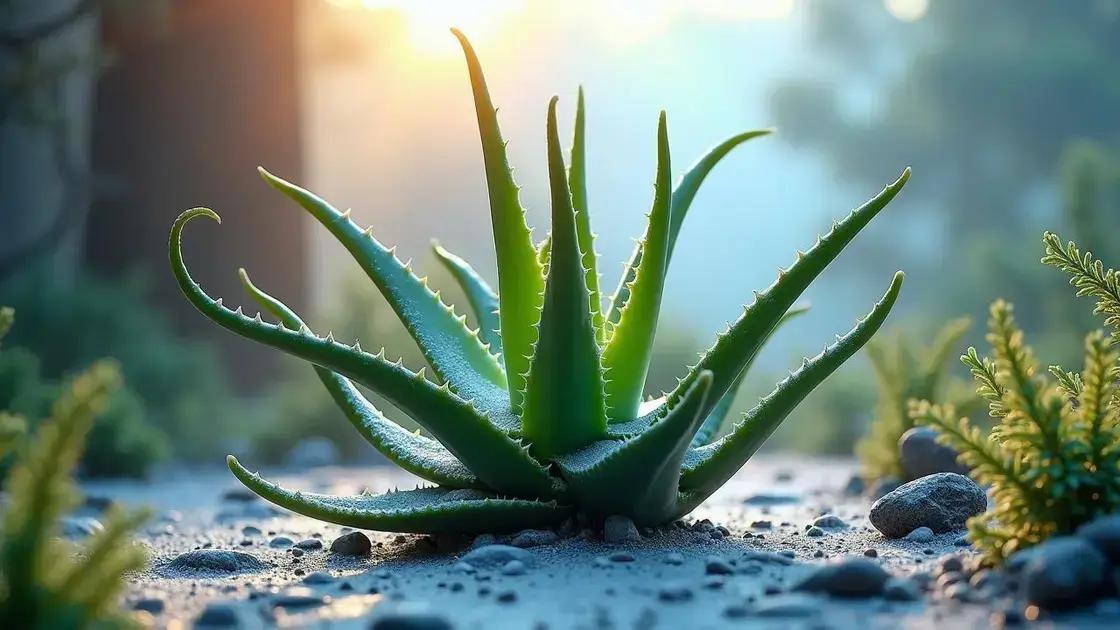How to Take Care of Aloe Plant in Winter: 5 Essential Tips for Success
How to take care of aloe plant in winter? As the seasons change, many plant lovers find themselves wondering about the best ways to ensure their indoor plants continue thriving. Understanding the specific requirements of your aloe plant during colder months is crucial for its health and vitality. With the right care and attention, your aloe can not only survive but thrive all winter long. Let’s explore the essentials to keeping your aloe thriving when the temperature drops.
Table of Contents
ToggleUnderstanding the unique needs of aloe plants in winter
How to take care of aloe plant in winter? Understanding the unique needs of aloe plants during colder months is essential for their health and growth. Aloe vera plants thrive in warm, sunny environments, but winter brings challenges that require careful attention. Ensuring your aloe remains healthy involves safeguarding it from the cold, managing light exposure, and adjusting watering schedules.
Caring for your aloe plant in winter
- Monitor temperature levels: Aloe plants prefer temperatures between 60°F and 75°F. Avoid exposing them to drafts or sudden temperature dips.
- Provide adequate light: Place your aloe in a south or west-facing window where it can receive ample sunlight. Consider using grow lights if natural light is scarce.
- Adjust watering frequency: During winter, aloe plants require less water. Water only when the top inch of soil feels dry to prevent root rot.
- Humidity control: Indoor heating can lead to dry air, which is not ideal for your aloe. Mist your aloe occasionally to maintain humidity levels, or use a pebble tray with water.
Identifying potential problems
- Yellowing leaves can indicate overwatering. If leaves become mushy, reduce watering.
- Brown tips often result from underwatering or low humidity.
- Watch for pests like mealybugs; they can harm your aloe plant.
Practical examples of winter care
Many gardeners have found success in winterizing their aloe plants by employing the right strategies. For instance, adjusting the watering schedule according to environmental conditions can have a remarkable impact. Those who provide additional lighting have seen noticeable growth even during the darkest months.
Benefits of understanding these needs
- Enhanced growth: By addressing your aloe plant’s specific requirements in winter, you can promote healthier growth.
- Reduced maintenance issues: Proactively identifying problems can prevent major health concerns for your plant.
- Longevity: Proper winter care can extend the life of your aloe plant, allowing it to thrive for years to come.
For more insights on taking care of indoor plants during winter, consider exploring indoor gardening techniques that relate to the unique needs of succulents, including aloe.
Tips for effective indoor aloe plant care during winter

Tips for effective indoor aloe plant care during winter can make a significant difference in the health of your aloe vera. During the colder months, indoor conditions can change dramatically, making it vital to adapt your plant care routine accordingly. With the right approach, you can keep your aloe thriving even in winter.
1. Adjust watering habits
Aloe plants naturally require less water in winter. Here are effective strategies:
- Check the soil moisture: Before watering, always test the top inch of the soil. Water only when it feels dry.
- Reduce frequency: Typically, watering every 2-3 weeks is adequate during winter months.
- Observe plant behavior: Yellowing leaves may indicate overwatering, while dry, crispy edges suggest underwatering.
2. Optimize lighting for aloe growth
Providing optimal light is crucial for indoor aloe care during winter:
- Location is key: Place your aloe near south-facing windows for maximum sunlight exposure.
- Supplement with artificial light: If natural light is insufficient, consider using grow lights to maintain healthy growth.
- Rotate your pot: Ensure equitable light distribution by rotating the container regularly.
3. Maintain appropriate temperature and humidity
Winter can lower indoor humidity, which affects your aloe plant:
- Temperature range: Keep your aloe in a comfortable environment around 60°F–75°F.
- Humidity levels: Use a humidifier or a pebble tray to increase humidity if necessary.
- Avoid drafts: Keep the plant away from doors and windows that can introduce cold drafts.
4. Inspect for pests
Ensuring your aloe plant is free of pests is vital:
- Regular checks: Inspect leaves for signs of pests like mealybugs or aphids.
- Quick treatment: If pests are detected, use insecticidal soap or neem oil promptly.
- Clean leaves: Wipe leaves gently with a damp cloth to maintain cleanliness and reduce pest attraction.
Employing these tips for effective indoor aloe plant care during winter will ensure a vibrant and healthy plant. And for more insights on exploring indoor gardening techniques that benefit various succulents, consider checking additional resources.
Common problems and solutions for wintering aloe plants
Common problems and solutions for wintering aloe plants can help you maintain a healthy aloe during the colder months. Aloe vera is a resilient plant, but it can face challenges in winter if not properly cared for. Understanding these issues and their solutions will enhance your aloe’s chances of thriving.
Identifying problems with aloe plants in winter
- Overwatering: Excess moisture can lead to root rot, especially when temperatures drop.
- Insufficient light: Aloe needs adequate sunlight; without it, your plant may become leggy and weak.
- Low humidity: Indoor heating can create a dry atmosphere that affects your aloe’s health.
Solutions for resolving common aloe plant issues
Addressing these issues promptly will ensure your aloe plant stays healthy:
- Watering adjustments: Check soil moisture levels regularly. Water only when the top inch feels dry.
- Improve lighting conditions: Position your aloe where it can receive at least 6 hours of bright, indirect sunlight. Use grow lights if necessary.
- Humidity management: Employ a humidifier or place a tray of water near the plant to increase humidity. Misting the leaves occasionally can also help.
Preventive measures for winter care
Taking proactive steps can prevent common problems:
- Inspect regularly for pests: Check leaves for signs of pests and treat them if found.
- Clean the plant: Maintain cleanliness by gently wiping leaves to remove dust and potential pests.
- Monitor environmental conditions: Be aware of cold drafts or extreme temperature fluctuations that could harm your aloe.
By anticipating these common problems and implementing effective solutions, you can enhance the health and resilience of your aloe plant throughout winter. For more tips on maintaining indoor plants, consider exploring indoor gardening techniques.
In conclusion
Caring for your aloe plant in winter requires understanding its unique needs and addressing potential challenges effectively. By adjusting your watering habits, providing adequate light, and maintaining optimal environmental conditions, you help your aloe thrive even in the cold months. Don’t forget to monitor for common problems and take proactive measures to ensure its health. For further insights and tips on enhancing your indoor garden, consider checking out additional resources.

